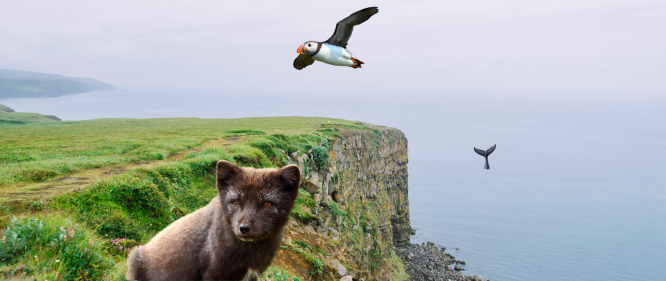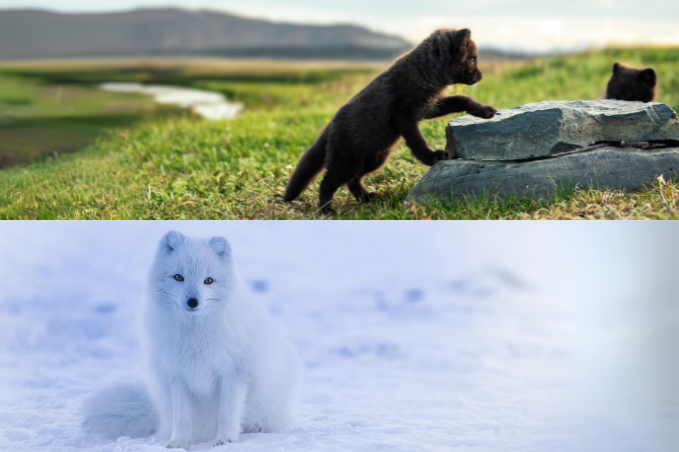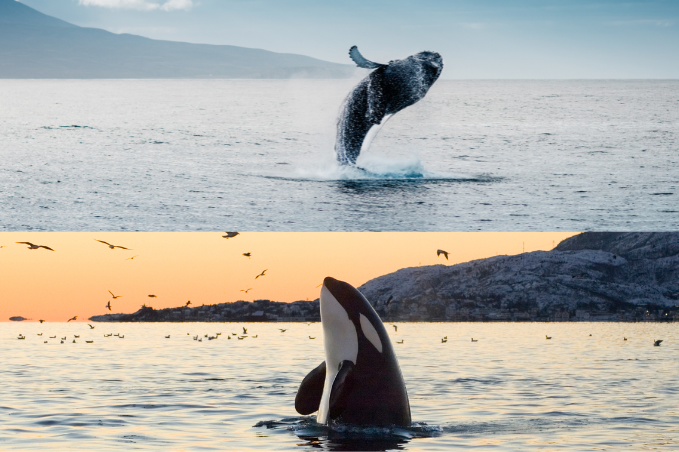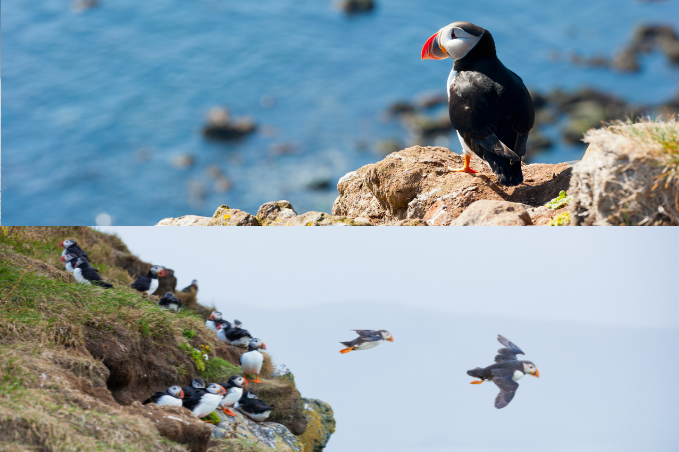Wildlife Adventures in Iceland: Foxes, Whales, and Puffins Await!

Iceland’s wildlife is as unique and resilient as the island itself. Despite the harsh weather and challenging landscapes, a remarkable variety of species have adapted to thrive here. From the Arctic fox, Iceland's only native land mammal, to the numerous whale species and vibrant puffins that visit the island, Iceland offers a fascinating glimpse into the lives of these hardy creatures.
The arctic fox
The Arctic fox is Iceland’s only native land mammal, most likely arrived on the island towards the end of the last ice age and surviving here long before the Vikings arrived. Despite facing harsh weather and conflicts with farmers since the age of settlement, these tough little creatures have thrived and continue to be a part of the rather limited Icelandic fauna. Some key facts about these furry creatures are, their compact build, they have smaller snouts, ears and tails then their European counterpart which helps them stay warm in the cold Icelandic climate. They come in various colors but tend to turn white in winter, otherwise they can be of various shades of brown to better blend into the landscape. Their diet consists mostly of birds, eggs, fish, and even the occasional sheep or seal although that is a very rare occurrence. Foxes pair for life, raising cubs in hidden dens. Their young become independent around four months after birth. They can be found across Iceland, especially in the Westfjords and the protected Hornstrandir Nature Reserve. Interestingly Icelandic Arctic foxes are oddly cautious around fences, preferring to walk around them rather than pass through! The Arctic Fox is a true survivor, perfectly suited to Iceland’s wild landscapes.

The Whales
Iceland is one of the top spots globally for whale watching, offering a chance to see 23 species up close in their natural habitat. Whether you're in Reykjavik, Husavik, or other coastal towns, whale watching is a must-do. The rich marine life here, thanks to the meeting of cold and warm currents, attracts baleen whales like Minke, Fin, Humpback, and even the Blue Whale, as well as toothed whales like Orcas and Sperm whales. The best time to watch them is from late spring to August. These whales range from the massive 30-meter Blue Whale to playful dolphins, and they communicate with unique sounds, with Humpbacks being known for their beautiful songs. Whale watching has become incredibly popular in Iceland, with Husavik often called the whale-watching capital. Tours are available across the country, offering unforgettable encounters. The Whales of Iceland museum in Reykjavik further enriches this experience, showcasing life-sized models and highlighting the importance of conservation. Whether on a boat tour or visiting the museum, Iceland provides an extraordinary glimpse into the lives of these majestic creatures.

The Puffins
Atlantic puffins are one of Iceland's most charming residents, spending most of their lives at sea but returning to land for breeding from April to September. Iceland is home to about 60% of the world's Atlantic puffin population, making it a top spot for seeing these colorful birds. Puffins are known for their penguin-like posture and bright orange beaks, which they use to attract mates in the spring. These skilled swimmers and divers can reach speeds of 80 km/h and dive up to 60 meters in search of their favorite foods, like herring and sand eels. You can spot puffins at various locations in Iceland, amongst them are Vestmannaeyjar (Westman Islands) also the largest puffin colony. Dyrhólaey, a small, easily accessible colony. Látrabjarg which is the Westfjords' largest bird cliff. Grímsey Island in the North of Iceland and Hafnarhólmi, in the East of Iceland, which has viewing platforms. Puffins tend to nest in large colonies, digging burrows with separate chambers for nesting and toilet use. They lay one egg each year, and both parents take turns caring for the chick. The best time to see them is from April to July, with some sightings possible until September. Unfortunately, puffins are now considered Critically Endangered in Iceland, primarily due to climate change. Conservation efforts are crucial to protect their dwindling population. Puffins are an iconic part of Iceland's wildlife, and seeing them in their natural habitat is a delightful experience that will surely brighten your day.

We hope this little insight into our wildlife has inspired you to go find them in their natural habitats here in Iceland, if you want to book any whale watching or puffin tours we recommend clicking here to see the variety of different tours and activities you can do while visiting us. See you soon on our shores!

